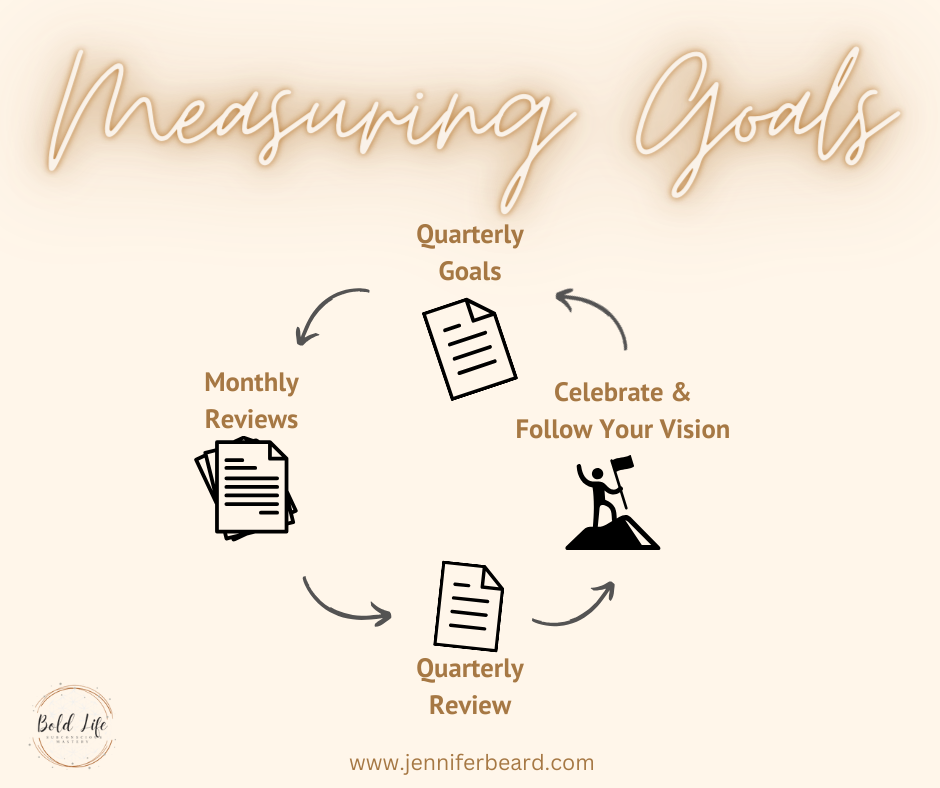Get the Guide
A simple, encouraging guide to help parents confidently transition into homeschooling, build a customized learning rhythm, and create a thriving educational experience at home.
Homeschooling 101 Starter Guide
Family
FAVE LINKS
Topics
Hi, I’m Jennifer — transformation coach, homeschooling mentor, and guide for parents ready to create a life that truly fits. I help you break through fear, align with your values, and confidently design both your child’s education and your own bold, authentic life.

For years I set goals, excited about a new adventure, I would move forward with speed and energy.
Over the course of 2 to 3 weeks I got distracted and sidetracked.
Several weeks later, having long forgotten my goal, I would often come across my goal in a journal or notebook and wonder what happened.
I was making such good progress and was so exhilarated about it too.
What I realized over time was that if I didn’t keep my attention steadfastly on my goal and track my movement forward, I completely forgot it existed.
It could have been THE solution to all my worldly problems. I couldn’t continue my mission past 3 weeks, no. matter. what.
After questioning this common occurrence and really taking into account all factors, it occured to me that unless I held my attention on this new endeavor, it was sure to fail.
What I have discovered since is that science backs up this thinking.
Here are two studies that support this realization:
- Study: “The power of specific and difficult goals: Participation in a goal-setting program improves college freshman academic performance” (Locke et al., 1984) [Place of study not explicitly mentioned]
- This study involved college freshmen who participated in a goal-setting program. The program emphasized setting specific and challenging goals, with participants regularly monitoring their progress. The results showed that those who set specific and monitored their progress achieved higher grades compared to those who didn’t participate in the program.
- Study: “Goal progress and attainment: Effects of goal setting and self-recording” (Matthews, 1995) – Conducted at Dominican College (now Dominican University of California)
- This research examined the impact of writing down goals and tracking progress. Participants were assigned goals and either wrote them down with weekly progress monitoring or simply kept them in mind. The findings indicated that those who wrote down their goals and tracked progress were significantly more likely to achieve them compared to the group that didn’t.
Even though we have good reason to track the progress of our goals people still often avoid the action of doing so.
Here are a few common objections people have to setting and tracking goals:
1. Overemphasis on Metrics: Some believe that focusing too much on metrics can detract from the quality and creativity of the work.
2. Constant Monitoring Can Be Demotivating: Continuous tracking might feel intrusive and demotivating, especially if progress is slow.
3. Loss of Flexibility: Setting specific goals can sometimes make it difficult to adapt to changing circumstances or new opportunities.
4. Resource Intensive: The process of setting and keeping track of goals can consume resources and time that might be used more effectively elsewhere.
5. Fear of Criticism: Individuals may avoid setting and tracking goals to not have to face potential criticism or judgment from others if goals are not met.
For years these reasons stood in between me and getting what I wanted out of life.
The unwillingness to overcome them limited my way forward.
For as long as I can remember, I wrote in my journal, capturing my life experience on paper.
It wasn’t until I finally decided to make it a rule to capture my goal progress that I started to see some real movement forward.
This behavior supported me in many ways, not just by keeping my attention firmly focused on my goals.
It also created a motivation loop. I wrote about my progress, felt motivated and inspired, and had a desire to come back for more.
The act of acknowledging the gains I made, encouraged more of the same behavior, gave me confidence that I could reach my goal, and made me aware of possible disruption.
Along the way, it also solicited more joy in my life overall, knowing I was moving into life intentionally and with purpose.
Happiness is the joy I feel striving for my potential.
– The Greeks
The journaling also assists me in the next step which includes pulling out the actual data.

Quarterly Tracking
The benefit of this step is that I can go back years later and see how far I’ve come. Setting quarterly goals is not a new concept. With the emergence of books such as:
- The 12 Week Year by Michael Bungay Stanier
- Traction: Get Grip on Your Business by Gino Wickman
- Measure What Matters by John Doerr
These ideas are certainly, not new, but the value of setting up your year this way is profound.
It gives us the ability to make great progress in a short period of time.
This is how my 1 Page Quarterly and Monthly goals work (FREE DOWNLOADABLE template HERE):
Quarterly Goal-Setting
1. Identify and Define Goals (Start of Quarter):
- Number of Goals: Stick to three or fewer to keep focused and manage resources efficiently.
- Goal Description: Clearly outline each goal, explaining your purpose, what is the motivation, and what impact do you want to have? What does the project look like when completed?
2. Action Plan:
- How do you plan to achieve it using the most impactful actions (the vital 20% based on the 80/20 rule). Highlight the key actions needed to reach your goals, lay out a timeline, assign responsibilities, and list necessary resources.
3. Document:
- Summarize this on a single page for clear visibility.
Monthly Progress Reports
1. Monthly Review (End of Each Month):
- Progress Summary: Track and record progress using both quantitative data (like numbers and metrics) and qualitative insights (like personal experiences), rating them from 1 to 10.
- Adjustments: Update your plan based on what’s working and what’s not.
2. Documentation:
- Keep reports to one page, with visual data summaries and brief narratives for easy review.
Quarterly Review
1. End of Quarter Assessment:
- Evaluate the overall impact, combining insights from monthly reviews to assess progress and learn from the journey.
2. Adjustment for Next Quarter:
- Adjust or set new goals as needed, based on your quarterly findings.
3. Document:
- Create a clear, visual report of your quarterly achievements.
4. Feedback and Sharing:
- Integrate feedback from mentors or invested participants.
This framework not only keeps you on track but also enhances reflection, ensuring you’re focusing on what really moves the needle.
By concentrating on the most effective actions, you’ll maximize both your productivity and success.
To get instructions on how to create this process and FREE DOWNLOADABLE TEMPLATES go here now.
Be Well,
Jennifer
p.s. Stay ahead of the game and join our community! Sign up for our weekly newsletter HERE to get exclusive insights, tips, and strategies right in your inbox. Don’t miss out on the chance to elevate your journey every week.
Michigan Life Coaching, Personal Growth, and PSYCH-K®️. Taking your life to the next level and creating the abundance you deserve.
Productivity
Homeschooling
authenticity
intuition
BeLIEF CHANGE
Browse the categories
JenniferBeard.com 2025. All Rights Reserved.
17195 Silver Lake Parkway #136 Fenton, MI 48430 | PRIVACY | TERMS
Hi, I’m Jennifer — transformation coach, homeschooling mentor, and guide for those who are ready to create a life that truly fits. I help you break through fear, align with your values, and confidently design both your child’s education and your own bold, authentic life.
HAPPINESS STARTS
WITH YOU!
Get this practical guide for living a life of joy now!
Start homeschooling confidently
Get the homeschool guide
Check out our private coaching




Comments Off on How to Manage Your Goals for the Greatest Results